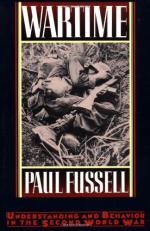
|
| Name: _________________________ | Period: ___________________ |
This quiz consists of 5 multiple choice and 5 short answer questions through Chapters 13 - 15.
Multiple Choice Questions
1. According to the stereotype about Chinese troops, they could survive indefinitely if provided with what?
(a) Soy bean rations.
(b) A handful of rice a day.
(c) Dry noodles.
(d) Dog meat.
2. When were most enduring war novels written?
(a) During the later days of the war.
(b) Before America's entry into the war.
(c) During the early days of the war.
(d) After the war.
3. Chapter 10 centers around the common soldier's perception of what characteristic of the war?
(a) Its ideological nature.
(b) Its diplomatic nature.
(c) The technology used in it.
(d) Its progress.
4. Most of the efforts discussed in America and Britain were aimed at which of the following?
(a) Reducing use of products.
(b) Getting citizens to manufacture products in their space time.
(c) Creating new products.
(d) Increasing the resiliency of industry.
5. Which of the following is NOT one of the reasons that armies historically favored younger soldiers?
(a) They do not question the war's irrationality.
(b) They are physically fit.
(c) They are obedient.
(d) They are aggressive.
Short Answer Questions
1. According to the rumor about servicemen's food, why was a certain substance added to their food?
2. Which of the following is NOT a major media type that supported the predominant media sources?
3. Which of the following is NOT one of the things that the author states to have been almost totally marred by high-mindedness during the war?
4. Which of the following best describes what the author believes about the US media's depiction of warfare?
5. Who controlled access to war zones for public media staff?
|
This section contains 293 words (approx. 1 page at 300 words per page) |

|




